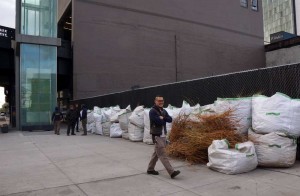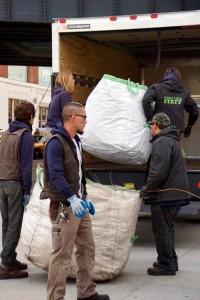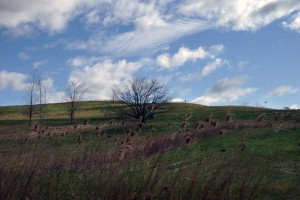Over the years there have been zillions of articles about the High Line Spring Cutback (including several on this blog), but until today I didn’t have a clue what a complex and coordinated operation the whole thing is. This morning I had the great privilege of watching and participating in Act II of the Cutback: removal of the clippings from Manhattan island and their transport to the Fresh Kills landfill on Staten Island, where they complete the circle of their natural life and become compost for someone else’s garden.
It is an amazing piece of choreography that takes place every week after the volunteers have put down their clippers. What was most remarkable to me is how this group — the extraordinary gardening staff of Friends of the High Line — works together so smoothly and easily each step of the way. Like they do it every week!
Here’s how it goes.
First: huge bags that the Cutback volunteers and gardening staff have filled with clippings throughout the week are loaded onto hand trucks and transported through the High Line’s bog to the 14th Street elevator.
Sticks, branches, etc. are carried out separately.
Thirty-some bags neatly line West 14th Street. (Bringing back memories of Madeline: “Thirty-three bags in two straight lines; They left the Line at half past nine….). As it turns out, there are a few too many bags to fit inside the panel truck, so three or four will make a rare trip back up the elevator to the Southern Spur and cool their jets for another week before moving along to Staten Island.
Into the truck they go. This part of the process reminded me of loading a dishwasher, because it’s not a perfectly straightforward operation and requires a certain amount of planning. Those members of the gardening staff who were born with the dishwasher-loading-gene direct the procedure and begin loading.
It gets tricky at the end: first the bags are stuffed, then crammed, into the truck. The sticks and branches are placed with extreme scientific precision at various points during the loading process, which the makes the unloading all the more interesting.
Notice how much fun these guys are having.
You did not have this much fun at your place of work this morning at half-past nine.
I make the trip with Maeve, one of the gardeners, and as we drive into Fresh Kills we see mountains of compost. Men are at work moving material from one large pile to a chipping machine.
This, volunteers, is the fruit of your labor from the week of 26 March: a thirty foot ridge containing the still-beautiful remains of the grasses, perennials, shrubs and trees that make the High Line the beautiful garden we all know and love. No one knows where it will end up next: perhaps in Prospect Park or Central Park as mulch? All we know for sure is that the life of these plants is not nearly finished.
Fresh Kills is a gorgeous place. Some day, deep in the future, there will be people kayaking, riding horses, walking through wetlands, grasslands, woodlands, and a wildlife habitat on what is planned to be a 2,200 acre “world class park.” (Read more about it here.) For now, though, it’s just rolling hills. If you put your mind on hold for a minute and gaze out across the landfill you could almost believe you’re in Scotland.
On the way home, Maeve points out the western end of the old Harsimus Stem Embankment, a massive stone structure that once supported seven tracks of the old Pennsylvania Railroad. The Embankment Preservation Coalition has been working for almost 15 years towards a goal of transforming the Embankment into a nature habitat and park; they’ve received important and consistent support from Friends of the High Line, and are making real progress. (Read more about it here.) Just a bit farther north, before reaching the Holland Tunnel, we pass another abandoned railroad embankment. Like many urban railways around the country, the most distinctive elements are graffiti and wild plants. I’m in the process of learning more about this structure, which was evidently an electrified railroad — see the bit of a catenary still visible in the lower left. Will post what I discover. (To read about other rail projects see “Urban Greenways.”)
Finally, back on the High Line, the empty bags are returned to the Southern Spur, ready for another batch of volunteers to start clipping, snipping, pruning, scraping, clearing…..
And the cycle will continue.





















